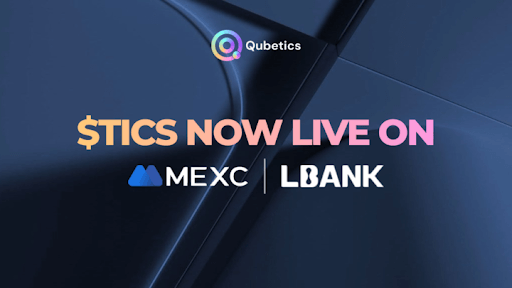The cryptocurrency market is once again proving its unpredictability, with established tokens like Maker (MKR) and OKB showing signs of stagnation, while Qubetics ($TICS) is commanding widespread attention. Following its explosive debut, Qubetics has not only delivered record-breaking returns for early buyers but also introduced real-world utility that sets it apart in a crowded altcoin space. In a single day, its trading volume on MEXC exceeded $700,000, and intense buy pressure near the $2 support level suggests it’s more than just a momentary hype cycle.
While Maker and OKB remain familiar names, Qubetics is actively shaping the next generation of blockchain utility and its successful launch.
QubeQode IDE: Web3 Development with Zero-Code Simplicity
At the heart of Qubetics lies its defining technological innovation, the QubeQode IDE. Unlike traditional development environments that require extensive knowledge of Solidity or deep familiarity with blockchain logic, QubeQode allows users to create decentralized applications through a visual, drag-and-drop interface. This no-code platform enables users to configure smart contracts, design token systems, and launch blockchain-based solutions entirely through forms and pre-integrated components. There’s no need for gas-fee testing or backend deployment headaches. In effect, QubeQode removes the friction that has long hindered mainstream adoption of blockchain technology.

For small businesses, marketers, and even Web2 developers transitioning into Web3, this IDE is a game-changer. For instance, a mid-sized eCommerce platform can tokenize its loyalty points within a few hours using QubeQode, transforming them into tradable digital assets without any technical bottlenecks. The platform also features a built-in code snippet library, filled with pre-tested logic for common tasks like token issuance, user authentication, and data handling. This lowers the development barrier significantly while speeding up the deployment cycle.
Delegators and Validators: The Power Behind Qubetics’ DPoS Governance
Qubetics implements a Delegated Proof of Stake (DPoS) governance model, which decentralizes power through participatory voting. Unlike traditional Proof-of-Stake systems, where stake weight alone determines influence, DPoS introduces an additional layer of accountability. To become a validator on the Qubetics network, a user must hold at least 25,000 $TICS tokens. These validators are responsible for validating transactions, producing blocks, and maintaining the overall security of the blockchain. However, their authority is not absolute; it’s earned and maintained by the community through delegation.
Token holders with at least 5,000 $TICS can participate as delegators. These users vote with their tokens, choosing which validator should represent them on the network. If a validator underperforms or acts against the community’s interest, delegators can reassign their support to a more competent node. This model ensures that network authority is not static or monopolized, but instead evolves based on performance, transparency, and reputation. It promotes a living governance system that is flexible, scalable, and inherently democratic. In Qubetics’ dPOS security ecosystem, participation is rewarded and power is distributed, not hoarded.
Qubetics: Explosive Launch and Market Confidence
Qubetics launched its $TICS token with a strong start, quickly becoming one of the most lucrative presale stories in recent memory. With a presale price of just $0.01 per token, early buyers saw astronomical returns as the token skyrocketed to $4.20 within an hour of listing. This 420x return caught the attention of traders and influencers across the space. Such a sharp and immediate price movement indicates not just hype, but significant buy-side momentum, driven by faith in the project’s underlying technology and tokenomics.
Within the first 24 hours, Qubetics recorded over 700k in trade volume on MEXC alone, signaling a healthy and active market from the outset. Additionally, the token found support around the $2 level, where consistent buy pressure continues to appear, suggesting that the market has accepted this zone as a fair valuation floor in the short term. This strong technical level gives both short-term traders and long-term buyers confidence in price stability. Paired with real-world tools like the QubeQode IDE and an incentive-rich governance system, Qubetics is not simply riding a speculative wave; it’s building utility that reinforces its valuation.
Maker (MKR): Market Stability with Modest Downside
Maker (MKR), the governance token behind the decentralized stablecoin protocol DAI, is currently trading at $1,937.68. Its 24-hour trading volume is $60,703,485, reflecting a minor 1.96% price decline. While the token remains a staple in the DeFi world, its price action has mainly been uneventful compared to that of emerging projects. MKR offers stability and a proven model but lacks the kind of dynamic, community-led engagement or innovation seen in newer tokens like Qubetics.
The protocol itself continues to function reliably, and MKR’s involvement in governance gives holders influence over the direction of DAI-related initiatives. However, the absence of recent product launches or ecosystem expansion limits speculative excitement. Investors looking for high-growth opportunities or early-stage participation may find Maker too mature for outsized returns in the short term. Still, it remains a dependable asset for those seeking long-term exposure to the foundational infrastructure of decentralized finance.
OKB: Exchange Utility, Limited Movement
OKB, the native utility token of the OKX exchange, is currently priced at $49.75, showing a mild 0.48% decline in the last 24 hours. Its daily trading volume sits at $4,556,149, a figure that suggests relatively low momentum for the week. OKB continues to serve its function within the OKX ecosystem, offering benefits like trading fee discounts, launchpad access, and loyalty rewards. However, its price action indicates that most of its utility is priced in and speculative growth is currently subdued.
While OKB does have long-term value as part of a well-established exchange, the token doesn’t currently present a catalyst or innovation comparable to what’s being introduced by Qubetics. In markets driven by emerging narratives and technological disruption, utility tokens like OKB often lag unless backed by aggressive platform updates or strategic partnerships. As it stands, OKB appears to be holding steady rather than positioning for any breakout moves.
Conclusion
Qubetics has emerged as a bold and functional force in crypto space. By combining an intuitive no-code development platform, community-driven governance, and an infrastructure-first approach, it is bridging the gap between blockchain complexity and real-world accessibility. The QubeQode IDE democratizes Web3 creation, making it possible for entrepreneurs, small teams, and even non-developers to build on blockchain. Its validator-delegator staking system adds a powerful layer of decentralization, and the recent 420x post-launch surge signals not just hype, but deeply rooted investor belief in its long-term potential.
In contrast, Maker and OKB remain stable but unexciting. Maker continues to hold value in the DeFi world but lacks the expansionary momentum needed to drive further price growth. OKB offers strong utility within its ecosystem, but with limited trading volume and no visible catalysts, it seems to be coasting on past achievements. For those seeking the next wave of crypto innovation, Qubetics is best crypto to invest in July 2025 proving itself as a standout contender one that offers not only speculative opportunity, but lasting usability.
For More Information:
Qubetics: https://qubetics.com/
Telegram: https://t.me/qubetics/
Twitter: https://x.com/qubetics/
FAQs
1. What is QubeQode IDE, and who can use it?
QubeQode is a no-code development environment for building blockchain applications. Anyone from startups to solo entrepreneurs can use it to build dApps without technical knowledge.
2. What’s the difference between a validator and a delegator on Qubetics?
Validators run the network and require 25,000 $TICS; delegators vote for them with 5,000 $TICS and share the rewards.
3. How high did Qubetics ($TICS) go post-launch?
It reached an all-time high of $4.20 within an hour, marking a 420x return from its presale price of $0.01.
4. Is Qubetics interoperable with BTC?
Yes, Qubetics supports seamless cross-chain interaction with BTC without needing bridges or KYC.
5. Why is Qubetics getting attention while MKR and OKB fall?
Because of its strong launch, utility-driven ecosystem, and real innovation in developer tools and governance.
Summary
Qubetics ($TICS) is disrupting the crypto landscape with its no-code QubeQode IDE, DPoS-based governance model, and record-breaking 420x launch performance. Offering up to 30% APY for validators and enabling non-technical users to build dApps through drag-and-drop tools, Qubetics makes blockchain development truly accessible. With $700K+ in launch-day volume and a strong $2 support zone, it’s a rising star among altcoins.




